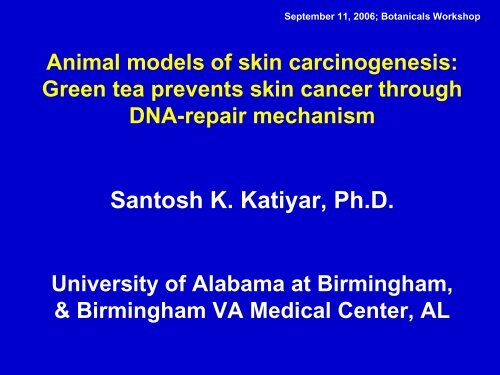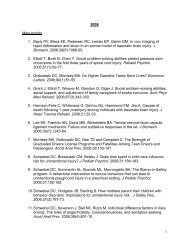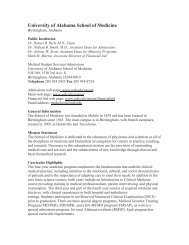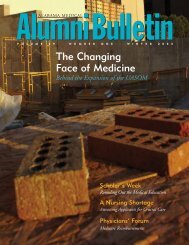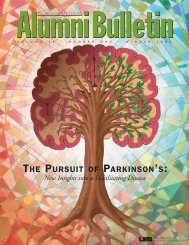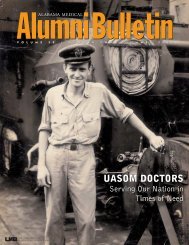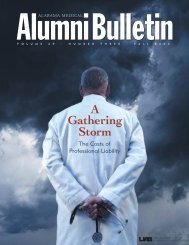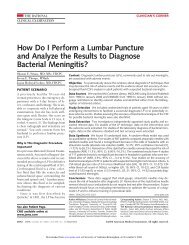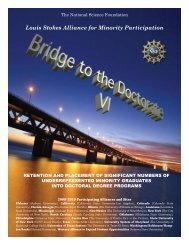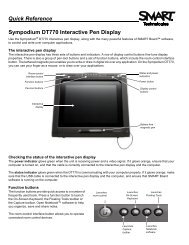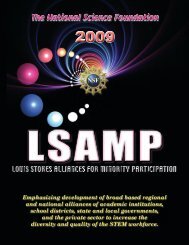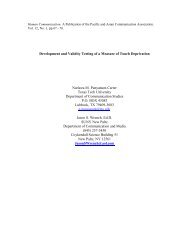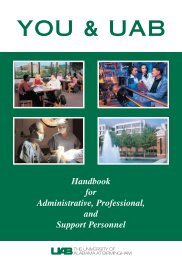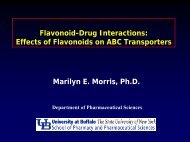Santosh K. Katiyar, Ph.D. - University of Alabama at Birmingham
Santosh K. Katiyar, Ph.D. - University of Alabama at Birmingham
Santosh K. Katiyar, Ph.D. - University of Alabama at Birmingham
You also want an ePaper? Increase the reach of your titles
YUMPU automatically turns print PDFs into web optimized ePapers that Google loves.
September 11, 2006; Botanicals Workshop<br />
Animal models <strong>of</strong> skin carcinogenesis:<br />
Green tea prevents skin cancer through<br />
DNA-repair mechanism<br />
<strong>Santosh</strong> K. <strong>K<strong>at</strong>iyar</strong>, <strong>Ph</strong>.D.<br />
<strong>University</strong> <strong>of</strong> <strong>Alabama</strong> <strong>at</strong> <strong>Birmingham</strong>,<br />
& <strong>Birmingham</strong> VA Medical Center, AL
• There are more than 3000 different diseases<br />
or disorders <strong>of</strong> the skin, hair and nails, which<br />
in an average year affect about 60 million<br />
Americans.<br />
• The combined annual cost to society <strong>of</strong><br />
medical care and lost wages from these<br />
conditions is estim<strong>at</strong>ed to be in the billions.
• The skin is one <strong>of</strong> the largest organs in the<br />
body, having enormous surface area ranging<br />
from 1.5-2.0m 2 and making up about 16% <strong>of</strong><br />
body weight.<br />
• Skin is constantly exposed to chemical agents<br />
and other environmental pollutants. N<strong>at</strong>ional<br />
Institute <strong>of</strong> Occup<strong>at</strong>ional Safety and Health<br />
(NIOSH) characterized skin diseases as one <strong>of</strong><br />
the most pervasive occup<strong>at</strong>ional health<br />
problems in the Unites St<strong>at</strong>es. D<strong>at</strong>a from the<br />
Bureau <strong>of</strong> Labor St<strong>at</strong>istics indic<strong>at</strong>e th<strong>at</strong> skin<br />
diseases <strong>at</strong>tributed to work place exposures<br />
accounts for more than 30% <strong>of</strong> all reported<br />
occup<strong>at</strong>ional diseases.
Cancer St<strong>at</strong>istics<br />
• The risk <strong>of</strong> cancer is a growing health problem<br />
around the world particularly associ<strong>at</strong>ed with the<br />
constantly rise in life expectancy, changes in<br />
environmental conditions, dietary habits and<br />
lifestyle.<br />
• According to current projections, one in five<br />
Americans will develop <strong>at</strong> least one nonmelanoma<br />
skin cancer during their life-time.<br />
• Approxim<strong>at</strong>ely 1.3 million new cases <strong>of</strong> skin<br />
cancers are diagnosed each year in the United<br />
St<strong>at</strong>es, which is equivalent to the incidence <strong>of</strong><br />
malignancies in all other organs combined.
Causes <strong>of</strong> Skin Cancer<br />
• Following major factors contribute to the<br />
skin cancer incidence:<br />
– Heredity characters, e.g. Mut<strong>at</strong>ions like<br />
addition, deletion, and substitution etc. in<br />
genome.<br />
– Environmental factors, e.g. UV radi<strong>at</strong>ion,<br />
polycyclic arom<strong>at</strong>ic hydrocarbon (PAH) or<br />
toxic chemicals<br />
– Dietary factors, e.g. diet containing toxic<br />
ingredients, charcoal roasted me<strong>at</strong> etc.
Type <strong>of</strong> Skin Cancer/Carcinogenesis:<br />
Animal Models<br />
• Chemical carcinogenesis: Initi<strong>at</strong>ed by exposure to<br />
chemical carcinogens like ubiquitous environmental<br />
pollutant, benzo(a)pyrene [B(a)P] and/or 7,12-<br />
dimethylbenz(a)anthracene (DMBA). Following<br />
carcinogen exposure, tumor promoters may be<br />
required to speed up the process <strong>of</strong> carcinogenesis.<br />
– Tumor promoters<br />
• TPA (12-O-tetradecanoylphorbol-13-acet<strong>at</strong>e)<br />
• Mezerein<br />
• Benzoylperoxide (BPO)<br />
• <strong>Ph</strong>otocarcinogenesis: Initi<strong>at</strong>ed and/or promoted by<br />
ultraviolet (UV) radi<strong>at</strong>ion. UV is also a complete<br />
carcinogen.
Multi-stage carcinogenesis model showing<br />
initi<strong>at</strong>ion, promotion and progression stages<br />
Sensitive to carcinogen (SENCAR) mouse model for chemical carcinogenesis.<br />
SKH-1 hairless mouse model for photocarcinogenesis
Multi-stage carcinogenesis model leading to the development <strong>of</strong><br />
papillomas and subsequent progression to carcinomas.<br />
Initi<strong>at</strong>ion<br />
Promotion<br />
Rel<strong>at</strong>ive Tumor Yield<br />
Papilloma<br />
Carcinoma<br />
+ +<br />
_ _<br />
++ + ++<br />
+ ++ + +<br />
++ +<br />
_<br />
+<br />
_<br />
_ _<br />
Applic<strong>at</strong>ion <strong>of</strong> large dose <strong>of</strong><br />
DMBA<br />
Applic<strong>at</strong>ion <strong>of</strong> small dose <strong>of</strong><br />
DMBA<br />
Applic<strong>at</strong>ion <strong>of</strong><br />
TPA
UV Radi<strong>at</strong>ion and Facts<br />
• Although several environmental, genetic and dietary<br />
factors contribute to the development <strong>of</strong> skin cancers,<br />
the most important is the chronic exposure to solar UV<br />
radi<strong>at</strong>ion.<br />
• Epidemiological, clinical and experimental biological<br />
studies have shown th<strong>at</strong> solar UV radi<strong>at</strong>ion is the major<br />
etiologic agent in skin cancer development.<br />
• UV radi<strong>at</strong>ion, particularly UVB (290-320 nm) spectrum,<br />
acts as a tumor initi<strong>at</strong>or, tumor promoter as well as a<br />
complete carcinogen.<br />
• UV irradi<strong>at</strong>ion to skin gener<strong>at</strong>es inflamm<strong>at</strong>ory responses,<br />
oxid<strong>at</strong>ive stress, immune suppression and DNA damage<br />
etc.. These factors contribute to various skin disorders<br />
including high risk <strong>of</strong> skin cancer incidence.
Risk Factors<br />
• Risk factors are well defined for nonmelanoma skin cancer.<br />
Over-exposure to UV Radi<strong>at</strong>ion and fair skin type<br />
susceptible to sunburns are the predominant risk factors.<br />
Increasing frequency <strong>of</strong> exposure, age, and male gender also<br />
contribute to increased risk.<br />
• The incidence <strong>of</strong> skin cancers, especially SCCs, is also<br />
increased among organ transplant recipients. Kidney and<br />
heart transplant recipients showed a 66-fold increased risk<br />
<strong>of</strong> SCC compared with the general popul<strong>at</strong>ion.<br />
• A comprehensive study <strong>of</strong> 5,356 transplant recipients in<br />
Sweden showed a 100-fold increased rel<strong>at</strong>ive risk <strong>of</strong><br />
nonmelanoma skin cancer, almost exclusively in sunexposed<br />
areas. The increased frequency <strong>of</strong> SCC in these<br />
p<strong>at</strong>ients presumably <strong>at</strong>tributable to long-term<br />
immunosuppressive therapy, although non-immune<br />
mechanisms may also play a role.
Dietary supplements may have the ability<br />
to protect the skin from skin diseases.
Botanical Supplements<br />
• Epic<strong>at</strong>echins or polyphenols from green<br />
tea (Camellia sinensis)<br />
• Grape seed proanthocyanidins(Vitis<br />
vinifera)<br />
• Silymarin from the seeds <strong>of</strong> milk thistle<br />
(Silybum marianum)
Topical applic<strong>at</strong>ion <strong>of</strong> (-)-epigalloc<strong>at</strong>echin-3-<br />
gall<strong>at</strong>e (EGCG) from green tea prevents<br />
photocarcinogenesis in mice.<br />
NORMAL UVB-Alone EGCG+UVB<br />
Neoplasia, 5: 555-565, 2003
• EGCG prevents UVB-induced immune<br />
suppression, and UVB-induced immune<br />
suppression is considered as a risk factor for the<br />
development <strong>of</strong> non-melanoma skin cancer.<br />
• We have also shown th<strong>at</strong> inhibition <strong>of</strong> UVBinduced<br />
immunosuppression in mice by EGCG is<br />
associ<strong>at</strong>ed with the increased levels <strong>of</strong> IL-12.<br />
Carcinogenesis, 20: 2117-2124, 1999.<br />
• IL-12 has anti-tumor activity and DNA repair<br />
ability. Therefore,
Hypothesis<br />
• We hypothesize th<strong>at</strong> chemopreventive<br />
effect <strong>of</strong> EGCG against photocarcinogenesis<br />
is medi<strong>at</strong>ed through IL-12.
EGCG inhibits UVB-induced tumor incidence in<br />
WT mice but not in IL-12 KO mice<br />
% Mice with tumors<br />
100<br />
80<br />
60<br />
40<br />
20<br />
0<br />
Wild-Types<br />
UVB Alone<br />
EGCG+UVB<br />
40%<br />
(p
EGCG inhibits UVB-induced tumor multiplicity<br />
in WT mice but not in IL-12 KO mice<br />
No. <strong>of</strong> tumors/group<br />
80<br />
60<br />
40<br />
20<br />
0<br />
Wild-Types<br />
UVB Alone<br />
EGCG+UVB<br />
20 25 30 35<br />
Weeks<br />
62%<br />
p
EGCG inhibits tumor growth gre<strong>at</strong>er<br />
in WT than in IL-12 KO mice<br />
Tumor vol./tumor<br />
±SD (mm 3 )<br />
200<br />
150<br />
100<br />
50<br />
0<br />
Wild-Types<br />
81%<br />
UVB EGCG+UV<br />
200<br />
150<br />
100<br />
50<br />
0<br />
IL-12 KO<br />
39%<br />
UVB EGCG+UV
EGCG inhibits tumor growth gre<strong>at</strong>er<br />
in WT than in IL-12 KO mice<br />
Tumor vol./tumor<br />
±SD (mm 3 )<br />
200<br />
150<br />
100<br />
50<br />
0<br />
Wild-Types<br />
81%<br />
UVB EGCG+UV<br />
200<br />
150<br />
100<br />
50<br />
0<br />
IL-12 KO<br />
39%<br />
UVB EGCG+UV
EGCG reduces UV-induced CPDs rapidly in<br />
WT mice but not in IL-12 KO mice<br />
WT<br />
IL-12 KO<br />
Normal<br />
Control<br />
EGCG<br />
Control<br />
EGCG<br />
UVB-24 h<br />
UVB-½ h
EGCG reduces or repairs UV-induced CPDs<br />
rapidly in WT mice than in IL-12 KO mice<br />
% CPD + Cells<br />
100<br />
80<br />
60<br />
40<br />
20<br />
0<br />
WT<br />
* *<br />
½ h 24 h 48 h ½ h 24 h 48 h<br />
UVB<br />
EGCG+UVB<br />
*P
EGCG reduces or repairs UV-induced CPDs<br />
rapidly in WT mice than in IL-12 KO mice<br />
UVB<br />
EGCG<br />
Normal<br />
Wild-Types IL-12 KO<br />
+ + + +<br />
- + - +<br />
½h<br />
24 h
UV-induced Sunburn Cells<br />
• The form<strong>at</strong>ion <strong>of</strong> sunburn cells after UV<br />
irradi<strong>at</strong>ion is primarily a consequence <strong>of</strong> DNA<br />
damage.<br />
• We therefore investig<strong>at</strong>ed the possibility<br />
whether EGCG has the ability to stimul<strong>at</strong>e<br />
DNA repair in sunburn cells and th<strong>at</strong> it is<br />
medi<strong>at</strong>ed through IL-12?
EGCG repairs UVB-induced sunburn cells<br />
rapidly in wild-types than IL-12 knock out mice<br />
Percent sunburn cells<br />
1<br />
0.8<br />
0.6<br />
0.4<br />
0.2<br />
0<br />
Wild-types<br />
UVB<br />
EGCG + UVB<br />
*<br />
*<br />
*<br />
0 10 24 48<br />
Hrs. after UVB exposure<br />
*P
EGCG Repairs UVB-induced CPDs in XPA-<br />
Pr<strong>of</strong>icient Cells but not in XPA-Deficient Cells<br />
XPApr<strong>of</strong>icient<br />
XPAdeficient<br />
Control<br />
UVB<br />
EGCG +<br />
UVB<br />
24 hr post UV irradi<strong>at</strong>ion<br />
% CPD+ cells<br />
100<br />
80<br />
60<br />
40<br />
20<br />
0<br />
100<br />
80<br />
60<br />
40<br />
20<br />
0<br />
UVB<br />
p
EGCG repairs UVB-induced CPDs in XPApr<strong>of</strong>icient<br />
cells but not in XPA-deficient cells<br />
EGCG<br />
UVB<br />
XPAdeficient<br />
XPApr<strong>of</strong>icient<br />
Dot-blot Analysis<br />
- + - +<br />
- - + +<br />
24 hr post UVB irradi<strong>at</strong>ion
Conclusion<br />
• EGCG from green tea has the ability to<br />
enhance the repair <strong>of</strong> UVB-induced DNA<br />
damage through induction <strong>of</strong> IL-12, which may<br />
lead to prevention <strong>of</strong> photocarcinogenesis.<br />
• Although it is possible th<strong>at</strong> not all cells with<br />
UVB-induced DNA damage may be repaired<br />
or elimin<strong>at</strong>ed using EGCG, the reduction in<br />
UVB-induced DNA damage by EGCG should<br />
be beneficial.
Financial Support<br />
• N<strong>at</strong>ional Cancer Institute (NCI)<br />
• N<strong>at</strong>ional Institute <strong>of</strong> Environmental Health<br />
Sciences (NIEHS).<br />
• NCCAM/NIH<br />
• Cancer Research & Prevention Found<strong>at</strong>ion<br />
• Veterans Administr<strong>at</strong>ion<br />
• UAB/Purdue Botanical Center<br />
• UAB Skin Diseases Research Center<br />
• Mitsui Norin Co. Ltd., Japan
Working Support<br />
• Anshu Mittal, <strong>Ph</strong>.D.<br />
• Praveen Vayalil, <strong>Ph</strong>.D.<br />
• Manjeshwar Baliga, <strong>Ph</strong>.D.<br />
• Sudheer Mantena, <strong>Ph</strong>.D.<br />
• Som D. Sharma, <strong>Ph</strong>.D.<br />
• Syed M. Meeran, <strong>Ph</strong>.D.<br />
• Suchitra <strong>K<strong>at</strong>iyar</strong>, MPH<br />
• Suhail Akhtar, <strong>Ph</strong>.D.
Thanks for<br />
kind <strong>at</strong>tention !


